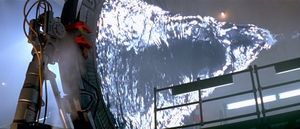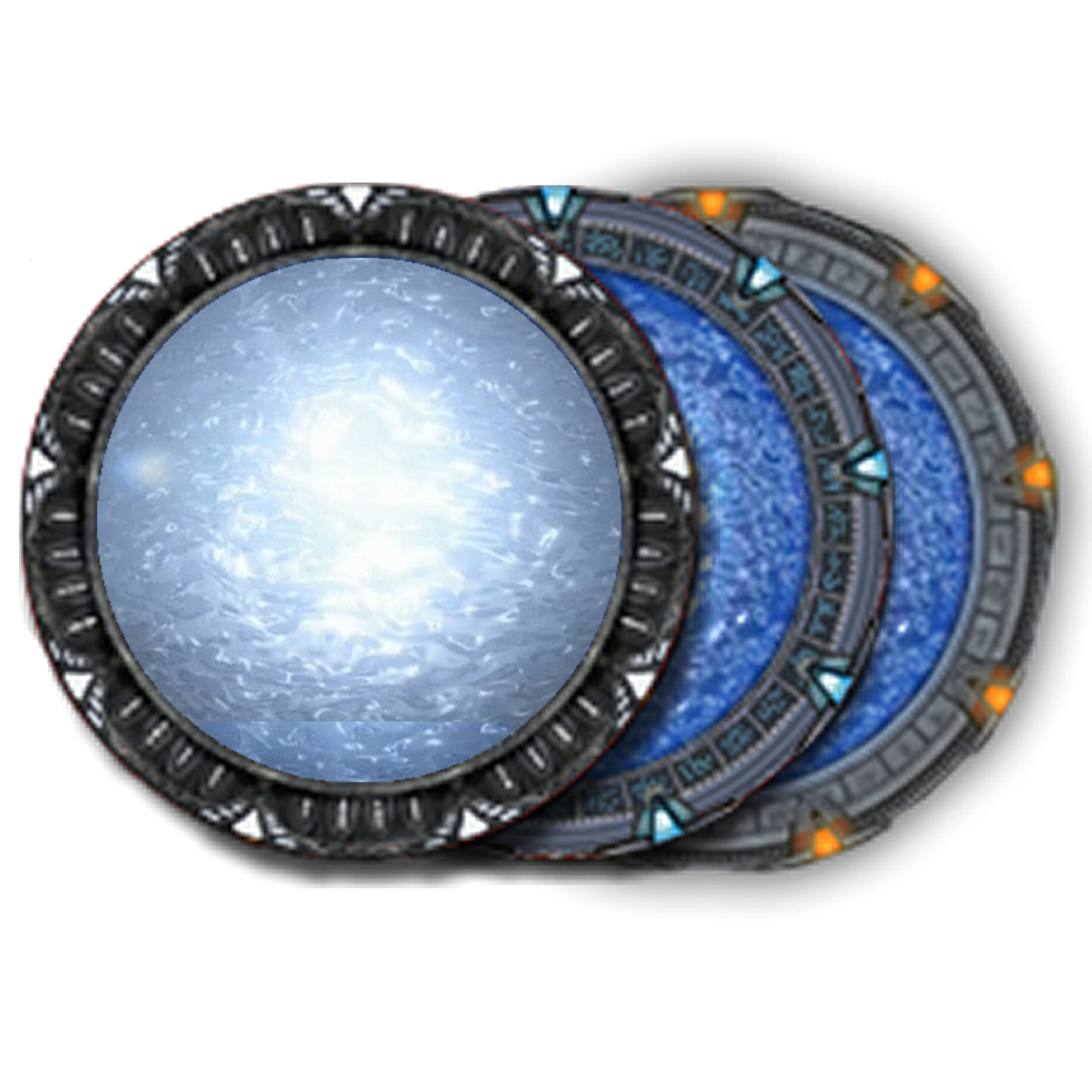Help:Canon
 | This page documents a Semantic Stargate Wiki guideline. This guideline is generally accepted among editors and is considered a standard (not policy) that all users should follow. However, it is not set in stone and should be treated with common sense and the occasional exception. When editing this page, please ensure that your revision reflects consensus. When in doubt, discuss first on the talk page. |
The SG-1/Atlantis/Universe canon refers to the Stargate universe depicted in Stargate SG-1, Stargate Atlantis and Stargate Universe and the universe that this wiki is dedicated to. This universe is based on the one depicted in the Stargate film, but there are some differences. However, it is clear that the events depicted in the film did occur in the SG-1/Atlantis/Universe universe and elements of the film are considered canon so long as they aren't directly contradicted by the series.
There are many novels, comics, role playing games and other works set in this universe, meaning they use the characters and elements of the Stargate universe as seen in the SG-1/Atlantis/Universe canon to create storylines. According to the GateWorld Omnipedia, even if there is a group who checks all the licensed media tie-ins to fit in the Stargate universe, they are considered as an "extended universe". Thus, Semantic Stargate Wiki DOES NOT recognize any games, novels, comics, RPGs, and other stuff as canon. Semantic Stargate Wiki considers them as a separate continuity. See SG:Jihad for more details.
"Canon" and "Non-Canon"
In science-fiction works, the term "canon" describes characters, events, and locales that are generated, recognized officially by the creators of the fictional universe, and shown to an audience in the context of a dramatized or written story. The term was originally a term used to differentiate heretical from accepted scripture in the Catholic Church.
A "non-canonical" story, in comparison, is not considered an official element of the storyline in a particular work of fiction, commonly a series of novels of a television program.
For fans of the work, identifying canonical stories, characters and the like can reduce the level of confusion in keeping track of storylines. Determining whether an officially-licensed work is canonical or not is often a point of debate for many fans of a show or story. Aside from that, the distinction is mainly important for the shows' writers who need to know what source material to use and can't be expected to know the details of dozens or possibly hundreds of novels.
The SF television show Babylon 5 is unique in that all published works are considered canonical by the series's creators. However, other shows such as Star Trek have many officially licensed stories (books and comics) that are considered non-canonical and whose story content is therefore sometimes contradicted by the aired episodes or theatrical films later. The Star Wars franchise generally attempts to unify its licensed novels and comics into the central movie storyline, but the movies are not bound by details established in the novels either; while they sometimes make references to novels or comics, they also contradict them in other places.
List of official Stargate products considered as canon in Semantic Stargate Wiki
The following are considered as canon in this wiki:
- Stargate, the movie which originated the franchise (except some details shown below),
- All Stargate SG-1 episodes, including deleted scenes and DVD commentaries,
- Stargate: The Ark of Truth and Stargate: Continuum, including deleted scenes and DVD commentaries,
- All Stargate Atlantis episodes, including deleted scenes and DVD commentaries,
- All Stargate Universe episodes, including deleted scenes and DVD commentaries,
- All Kino webisodes,
- Stargate Origins, despite the fact that no creator of the franchise was involved in the production.
All the rest, i.e. Stargate Infinity, all novels adapted from the movie or the series, the RPGs, comics, games, audio books, "official" magazines, etc. ARE NOT part of the canon and shall not be included in "canon" articles. This stuff must be part of separate articles with the {{Separate continuity}} tag to avoid confusion.
Complications within the series
Internal contradictions
There are some elements of the series that are considered to be inconsistencies and therefore not exactly canon. For example, in the scene from the SG-1 episode "Solitudes" where P4A-771 is being dialed from the SGC, archive footage of the dialing computer was reused, so the gate address depicted is actually that of Abydos. Since it would be impossible for Abydos and P4A-771 to have the same gate address, the address portrayed in the episode must be inaccurate, despite the fact "Solitudes" is part of the official SG-1/Atlantis/Universe canon. However these kinds of mistakes are generally considered excusable and understandable as they mostly serve to lower production costs.
Time travel
On more than one occasion, the SG-1's narrative has followed characters jumping backwards in time, effectively creating a new timeline in which history has been changed by their presence. Thus, there are technically six distinct timelines in which major portions of the series take place: one from Stargate to the beginning of "Moebius", Part 1, a second from "Moebius" to "The Last Man", third from "The Last Man" to "Time", and two within "Time", with the fifth from "Time" to "Twin Destinies", and the sixth during "Twin Destinies" and after. The focus of this wiki is the post-"Twin Destinies" timeline, as it's the setting of the series as of 2010 (see Help:Timeline); however, articles generally assume that this timeline is identical to the previous five, except where explicitly shown otherwise.
Similarly, Stargate: Continuum features a time-travel story that creates yet another 2 timelines, which brings the grand total of timelines to eight.
Alternate timelines created through time travel are distinct from the alternate realities accessible through a quantum mirror or similar technology, which exist simultaneously with one another in the same timeline.
Other Stargate universes
Stargate, the movie canon

This is the universe depicted in the 1994 science-fiction film Stargate. Bill McCay's Stargate novels and the Entity Comics are set in this universe, but the canon status of these materials for this timeline remains unclear.
The physical appearances of many characters, notably Jack O'Neill, Catherine Langford and Ferretti, are radically different in this universe, due to them being played by different actors. Other differences are listed below:
| Stargate, the movie canon | SG-1/Atlantis/Universe canon |
|---|---|
| "Jack O'Neil" | "Jack O'Neill" |
| "Sha'uri" | "Sha're" |
| "Feretti" | "Ferretti" |
| "Sarah O'Neil" | "Sara O'Neill" |
| "Tyler O'Neil" | "Charlie O'Neill" |
| Two Guards attempted to return through the Stargate after it was buried. They were transported into the stone, instantly fossilizing them. | If a Stargate is buried, it will not be able to activate. Even if some sort of barrier is far enough from the event horizon, the matter heading through will not be able to reintegrate, essentially "splattering" against the barrier. |
| The Stargate is stored inside Creek Mountain. | The Stargate is stored inside Cheyenne Mountain. |
| Dr. Jackson says he does not know who built the pyramids, because they were far older then the Egyptian empire. | Dr. Jackson is called the laughing stock of the archaeological community for claiming during his lecture that aliens built the pyramids. |
| The blast doors that obscure the gate are in front of the window in the briefing room. | The blast doors that obscure the gate are on the outside of the window in the briefing room. |
| The briefing room is a couple floors above the control room. | The briefing room is directly above the control room. |
| The ramp to the Stargate consists of several sections; two sets of stairs on either side of one end of the ramp give access to the ramp, which itself bridges a large hatch, a remnant of Creek Mountain's origins as a nuclear missile silo. | The Stargate is accessed by a simple ramp, and no missile silo hatch is evident. The ceiling retracts, allowing for the Stargate to be removed and replaced. |
| The symbols are engraved into the gate. | The symbols protrude from the gate. |
| The top chevron is aesthetically different from the others. | All of the chevrons are identical. |
| None of the chevrons glow. | All of the chevrons glow. |
| A spinning, funnel-shaped whirlwind ("the strudel") extends from the back of the gate after it's activated. | The back of an activated gate has a flat water-like surface like the front. A notable exception is the episode "A Matter of Time," where a similar formation was created when the gate was linked to a black hole. |
| Abydos is "on the other side of the known universe" and is located in the Kaliem Galaxy. | Abydos is located in the Milky Way and is one of the closest planets in the gate network to Earth. Eight chevrons are needed to reach a gate in another galaxy. |
| Ra's species is humanoid and it is not explained how he took over the body of an Egyptian boy. | Ra's race, the Goa'uld, are snake-like parasitic creatures. |
| Ra's Royal Guards are made up of humans, raised and indoctrinated by Ra, each to pose as different gods from the Egyptian religious pantheon in order to effectively control the enslaved human population. | Goa'uld are guarded by Jaffa, which apparently do not exist in the movie's universe. |
| -- | According to the series, Goa'uld motherships have shields that prevent ring transporters from working, making it seem rather foolish for Ra to keep the shields down when he would know the Jaffa he had sent down had been killed. Of course, this could be attributed to his Goa'uld arrogance. |
| The symbols on Abydos's gate are completely different from those on Earth's. | All gates in the Milky Way use a standard set of symbols, except for the point of origin. |
| Anubis and Horus are Ra's Guards with the mark of Ra visible on their arm. | Anubis is the most powerful Goa'uld System Lord and is also a half ascended being. Horus is another name for Heru'ur another System Lord. Jaffa bear the mark of their god on their foreheads instead of their arm. |
Infinity universe
This is the universe depicted in Stargate Infinity, which is based on the universes depicted in Stargate and Stargate SG-1. Infinity is not considered as canon and is thus a separate continuity.
Differences between the SG-1/Atlantis/Universe and the Infinity universe
- The unstable vortex does not annihilate whatever it comes into contact with.
- The Ancients are winged, telepathic creatures.
- The Stargates only have eight chevrons.
References and notes
| This page uses content from Stargate Wikia. The original article was at Stargate canon . The list of authors can be seen in the page history. As with Semantic Stargate Wiki, the text of Stargate Wikia is available under the Creative Commons Attribution-ShareAlike 3.0 Unported (CC BY-SA 3.0). |


